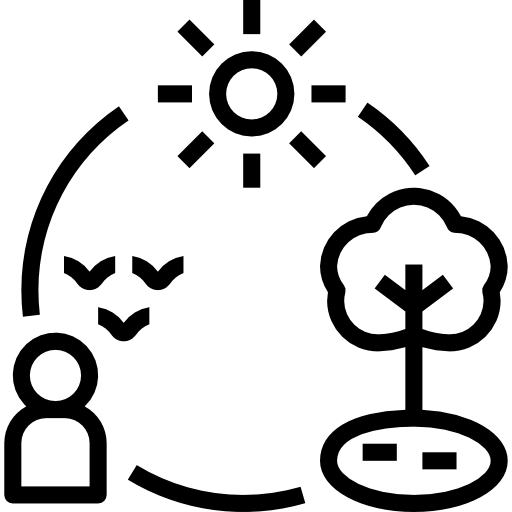Dragon1 Icon for
Ecosystems CREATED BY ANONYMOUS, CREATIVE COMMONS LICENSE
CREATED BY ANONYMOUS, CREATIVE COMMONS LICENSEDragon1 Definition for
Ecosystems:
Ecosystems are complex communities of organisms, such as plants, animals, and microorganisms, interacting with each other and their physical environment, such as water, air, and soil.
Let us define Ecosystems
What are ecosystems, and what are the different types of ecosystems? How do you visualize ecosystems, and what is a business ecosystem? Please read it here!
Definition of Ecosystems
What are Ecosystems meaning?
Ecosystems are complex communities of living organisms (plants, animals, and microorganisms) interacting with each other and with their physical environment (water, air, and soil) in a specific area.
Ecosystems can be large or small (tiny ponds to vast forests) and are often characterized by their unique features, such as the types of plants and animals present, the specific climate, and how energy and nutrients are exchanged within the system.
Each ecosystem is a complex and dynamic network of interactions, with the living and non-living components constantly affecting each other. This interdependence creates a delicate balance within the ecosystem, and any disturbance to one part of the system can have cascading effects on the entire ecosystem.
For example, plants absorb sunlight and use it to convert carbon dioxide and water into oxygen and sugar through photosynthesis. This process is vital for animals that breathe oxygen and consume plants or other animals for energy.
Ecosystems provide many benefits to humans, such as air and water purification, nutrient cycling, climate regulation, and recreational opportunities.
Organizations as Ecosystems
Viewing an organization as a digital ecosystem can provide valuable insights into its functioning, complexity, and resilience. It underscores the importance of recognizing and managing the interconnectedness of various components to foster a healthy and thriving organizational environment.
- Interconnected Components: Like a natural ecosystem of various species of plants, animals, and microorganisms, an organization comprises diverse components at all levels: employees, departments, teams, projects, processes, and resources. The interactions among these elements influence the overall functioning and performance of the organization.
- Interdependence: There is a web of interdependence among the various components in both ecosystems. In an organization, different departments and teams rely on each other's output to accomplish their tasks and achieve common goals, just as animals and plants in a natural ecosystem depend on each other for survival and growth.
- Flow of Resources and Energy: Energy and nutrients flow through food chains and webs in a natural ecosystem. Similarly, in an organization, there is a flow of resources (e.g., information, materials, finances) and energy (e.g., ideas, motivation, effort) through various processes and interactions, contributing to the functioning and growth of the organization.
- Adaptation and Evolution: Both natural ecosystems and organizations must adapt to changing conditions to thrive. Organizational adaptation may involve adopting new technologies, evolving strategies, or responding to market dynamics. Natural ecosystems evolve through processes like natural selection, where species better adapted to their environment are more likely to survive and reproduce.
- Balance and Resilience: Natural ecosystems have an inherent balance that allows them to cope with disturbances and maintain stability. Similarly, organizations strive for resilience by implementing risk management strategies and contingency plans and fostering a culture of adaptability.
- External Interactions: Just as a natural ecosystem interacts with its external environment through climate, geography, and neighboring ecosystems, an organization interacts with its external environment through customers, suppliers, competitors, regulatory bodies, and other stakeholders.
- Feedback Loops: Feedback loops exist in natural and organizational ecosystems. In an organization, feedback mechanisms, such as performance evaluations and customer feedback, are crucial in improving processes and fostering growth.
- Diversity and Specialization: Just as biodiversity is essential for a balanced natural ecosystem, diversity within an organization brings different skills, perspectives, and expertise that contribute to overall efficiency and innovation.
- Sustainability and Growth: Both natural ecosystems and organizations require sustainable practices to maintain stability and ensure long-term growth. In the context of an organization, this includes promoting employee well-being, investing in training and development, and maintaining a healthy work culture.
- Impact on Surroundings: Both ecosystems and organizations have the potential to impact their surroundings. A natural ecosystem can influence its environment's biodiversity and physical characteristics, while an organization can affect the social, economic, and environmental aspects of the communities in which it operates.
Achieve sustainable success
The Dragon1 software platform provides a powerful and comprehensive set of tools and capabilities that can be used to model, visualize, analyze, and manage your business as an ecosystem and formulate the ecosystems principle. Whether you're working on a small-scale project or a large-scale market strategy, Dragon1 can help to ensure that your business ecosystem management strategies are effective and sustainable. Create here your free Trial Account.
If you have comments or remarks about this Dragon1 term or definition, please mail to specs@dragon1.com.